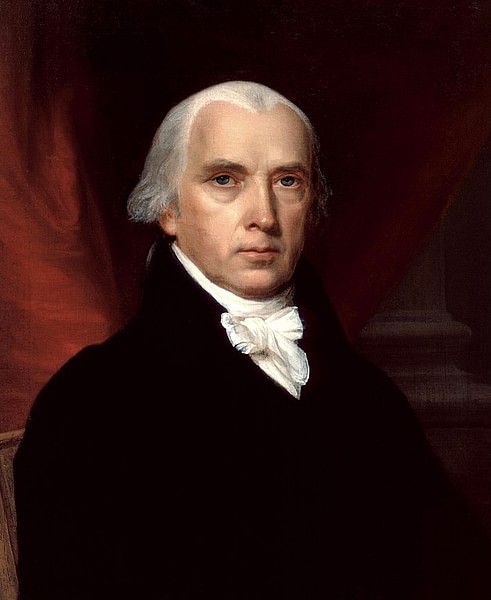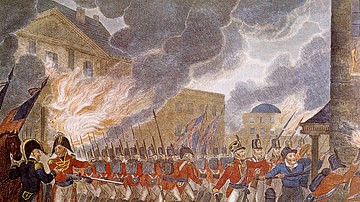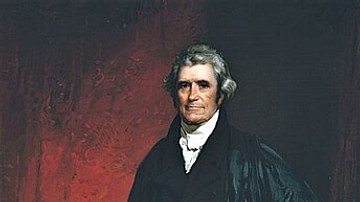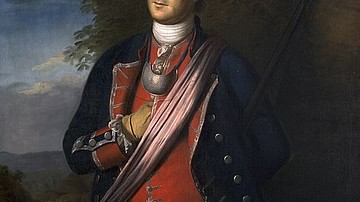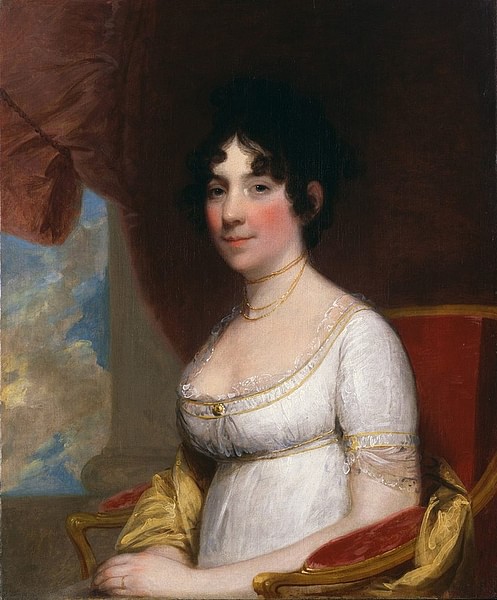
Dolley Madison (1768-1849), born Dolley Payne, was a prominent American First Lady, a function she held both during the presidency of her husband, James Madison, and for his predecessor, the widower Thomas Jefferson. Known for her elegance and charm, Madison acted as hostess of the White House, helping to define the role of the presidential spouse.
Early Life
Dolley Payne was born in the Quaker community of New Garden in Guilford County, North Carolina (present-day Greensboro), on 20 May 1768. She was one of eight children born to John Payne, a merchant, and his wife Mary Coles Payne, both of whom came from prominent Virginian families. Shortly after Dolley's birth, the family moved back to Virginia; although their reasons for moving are unclear, some historians have speculated that they had failed at business in North Carolina and wanted a fresh start, or that they were facing discrimination because of their Quaker religion. In any case, the family settled on a 176-acre farm in Hanover County, Virginia, where Dolley grew up. She spent her childhood working the land alongside her parents and siblings and was given a strict Quaker education.
Although John Payne had not been born into the Society of Friends – he had adopted the religion in 1765 to please his Quaker wife – he quickly proved a devoted Quaker himself. He stayed out of the American Revolutionary War (1775-1783) to adhere to the Quaker doctrine of pacifism, and his family was not much affected by the fighting. Prior to his conversion, Payne had been a slaveholder, but now became "doubtful and afterwards conscientiously scrupulous about…holding slaves as property" (quoted in Feldman, 384). He desperately wanted to emancipate his slaves, but, since Virginia forbade voluntary manumission, Payne was forced to pack up his family and move them yet again. This time, they went to Philadelphia, Pennsylvania, which was not only the second largest city in the newly independent United States but also a bastion of Quakerism. Here, Payne freed his slaves and moved his family into a house on North Third Street. Partnering with his oldest son, he opened a business to manufacture and sell starch.
In Philadelphia, 15-year-old Dolley continued her Quaker education. Her father forbade her studies from including music or dancing, which most young ladies of her status were expected to know; indeed, Dolley's niece would later write that the Payne daughters were denied "the acquirement of those graceful and ornamental accomplishments which are too generally considered the most important parts of the female education" (quoted in Feldman, 384). Still, the teenage Dolley had no lack of suitors, all of whom she rejected so as to not "relinquish her girlhood" (ibid). But Dolley could not expect to remain a spinster forever, especially not once her family began to fall on hard times. John Payne's starch manufacturing business had never taken off and finally failed in 1789. He then decided to put the money saved from the sale of the Virginia farm into speculative land investments but soon lost this money as well. Payne suddenly found that his family was "reduced to poverty", although the biggest blow of all was when he found himself ostracized from Quaker meetings for his poor financial management.
Distraught and desperate, John Payne arranged for Dolley to marry John Todd, a young lawyer and a Quaker. Dolley accepted – whether there was any love between her and Todd, or whether she was just playing the dutiful daughter, is unknown. In any case, they were married in January 1790, although the Paynes were unable to provide a dowry. John Payne lived long enough to see his daughter married off before dying in October 1792, having never recovered from the stresses of his failures. In the shadow of her father's death, Dolley Payne Todd gave birth to two children of her own: her oldest son, John Payne Todd (called Payne) was born on 29 February 1792, while a second son, William Todd, was born on 4 July 1793. As Dolley was settling into her new life as a mother, little could she have known that it all would soon be upended by death and tragedy.
Epidemic
In September 1793, a deadly yellow fever epidemic broke out in Philadelphia. Dolley Todd took her two infant sons and fled 3 miles (5 km) from the center of the city to Grays Ferry, on the Schuylkill River. Meanwhile, John Todd decided to stay at home, to care for his ailing father who had contracted the illness. Dolley herself was sick with worry over her husband's safety, writing that she was "distracted with distress and apprehension" (quoted in Feldman, 385). Soon, both of John Todd's parents succumbed to the fever, leaving him free to join his wife and children at Grays Ferry. No sooner had he done so, however, than he felt compelled to make a short trip back to Philadelphia, to close his law office and visit another sick relative. Dolley begged him not to go, but he did not listen. When he returned from the city, he had contracted the fever.
John Todd spent several agonizing days at Grays Ferry, staying in a separate room to not infect Dolley or the children. Eventually, however, it became apparent he was dying, so he returned to his home in Philadelphia where he "died in a few hours, so rapid was the plague" (ibid). The brief exposure to the sick Todd was enough to infect both Dolley and her infant son William, who both came down with the fever. While Dolley ultimately recovered, William did not, dying in October 1793. By time the epidemic was over in November, more than 5,000 people had died in a city of 50,000. At only 25 years old, Dolley was a widow, and was heartbroken for the recent losses of her father, husband, and son in quick succession.
Marriage to James Madison
It was in the spring of 1794, after the bodies of the dead were consigned to their graves, that Dolley Payne Todd met James Madison. At 43 years old, he was already one of the most famous men in America, a leader in Congress who was regarded by many as the 'Father of the Constitution'. At the same time, he was a timid man, short and frail, a lifelong bachelor, 17 years Dolley's elder. They were introduced by New York Senator Aaron Burr, and Madison was instantly "struck by her charms" (quoted in Feldman, 387). Dolley also must have taken a liking to the "great, little Madison" as she playfully referred to him in a letter to her sister; she invited him to her house where, as she would later boast, she "conquered the recluse bookworm Madison 'who was considered an old bachelor'" (ibid).
Shortly after this rendezvous, Dolley left Philadelphia to visit Virginia, where she was beset with letters from several suitors, including Madison. Her cousin would write her on Madison's behalf:
He thinks of you so much in the day that he has lost his tongue, at night he dreams of you and starts in his sleep a-calling on you to relieve his flame for he burns to such an excess that he will be shortly consumed and he hopes that your heart will be callous to every other swain but himself…he has consented to everything that I have wrote about him with sparkling eyes.
(quoted in Feldman, 389).
Whether these words had come from Madison's mouth, it was clear that he was quite taken with the young widow. He proposed marriage in August, and the couple were married on 16 September 1794, four months after having first met. Dolley, who may have consented to her first marriage out of duty, was fully in control of her decision to marry Madison, writing, "in the course of this day, I give my Hand to the Man who of all others I most admire"; after absentmindedly signing the letter 'Dolley Payne Todd', she corrected herself with the note: "Dolley Madison! Alass!" (Montpelier.org).
Since James Madison was not a Quaker, Dolley was expelled from the Society of Friends for marrying outside the faith. This did not seem to trouble her too much, and she hereafter attended Episcopal services with her husband. Dolley and James lived together in Philadelphia for the first three years of their marriage. Then, when James stepped down from Congress in 1797, she moved with him back to his plantation of Montpelier in Orange County, Virginia. Despite her Quaker upbringing and her own father's anti-slavery beliefs, there is no evidence that Dolley Madison disapproved of her husband as a slaveowner or objected to the nearly 100 enslaved people at Montpelier.
In Washington
Dolley and James Madison remained at Montpelier during the four years of John Adams' presidency. Then, in 1801, Thomas Jefferson won the presidency after a hotly contested election and invited his close friend and political ally, Madison, to serve as his secretary of state. James accepted, and the Madisons arrived in the newly built national capital of Washington, D.C., on 1 May 1801. The capital, at this time, was nothing more than a jumble of wood or brick buildings joined by muddy dirt roads, and populated by a mere 3,000 people. It was a far cry from the elegant Philadelphia and hardly seemed fit to serve as the heart of the 'empire of liberty' that Jefferson meant to forge. Yet it was in this city that Dolley Madison would thrive.
Both President Jefferson and Vice President Burr were widowers, leaving Dolley – as the wife of the secretary of state – the highest-ranking woman in the nation. She was, therefore, often asked to fill the role of hostess when President Jefferson held his famous weekly dinners in the White House. In an era rife with partisan divisions, Dolley soon became known as a conciliatory figure; whenever congressmen began to bicker at the start of one of Jefferson's dinners, the "sound of her high-heeled shoes" would serve to instantly lighten the mood, and "all ill feeling would be forgotten or suppressed and the topic changed" (quoted in Feldman, 445). Through her charm and social graces, she was able to resolve conflicts while subtly and deftly guiding her guests into siding with her husband.
In this way, Dolley Madison became a political player in her own right. She not only won friends and allies to Jefferson and Madison's side but also influenced Jefferson himself, acting as a voice of moderation for his more radical ideas. Jefferson valued her so much that he accidentally caused a scandal in 1803, when he escorted Dolley to dinner instead of the wife of the British ambassador, as protocol required. The ambassador interpreted this as a slight, which threatened to worsen relations between Britain and the United States at an already precarious time. Dolley diffused the situation by befriending the snubbed wife, Elizabeth Merry, and inviting the Merrys over to dinner, where she won them over with her charm.
First Lady
In 1808, James Madison won election as the fourth president of the United States. After the election, Dolley worked with architect Benjamin Latrobe to refurbish the White House in an elegant, neoclassical style reminiscent of the ancient Roman Republic that had inspired the American Founders. On the night of her husband's inauguration, 4 March 1809, Dolley Madison threw an inaugural ball, with a reception held at Long's Hotel near the Capitol Building. The Madisons entered the reception to a march composed specifically for the occasion; while the new president was dressed plainly in a black suit, one eyewitness observed that the First Lady "looked a queen…she had on a pale buff colored velvet, made plain, with a very long train, but not the least trimming, and a beautiful pearl necklace, earrings, and bracelets" (quoted in Feldman, 505). Indeed, Dolley Madison would soon become regarded as a fashion icon. Her signature look – which included low-cut, high-waisted dresses and white satin turbans – would soon be imitated by women across the nation.
In her capacity as First Lady, Dolley did for her husband what she had done for Jefferson, hosting dinners and winning allies. Every Wednesday evening, she would hold receptions in the White House, that would soon be referred to as 'squeezes' because they were so well-attended that guests would have to squeeze in very tightly to make room. Eschewing elitism, Dolley opened her weekly receptions to anyone who wanted to attend. She would move amongst the guests and make sure she spoke to everyone before the evening was done. She refrained from taking any hardline stances on issues of policy and was, therefore, able to soften her husband's political enemies. According to some historians, it was her charming influence that helped Madison garner enough support to win re-election in 1812.
That same year, the United States went to war with the United Kingdom, sparking the War of 1812. Two years later, on 23 August 1814, the British had advanced to right outside Washington, D.C., and were preparing to march on the city. As the capital devolved into a panic, Dolley Madison remained composed, stuffing "as many cabinet papers into trunks as to fill one carriage" (quoted in Feldman, 582). Rather than fleeing, she decided to remain in the White House to wait for her husband, who was off inspecting US troops at nearby Bladensburg; when the British attacked Bladensburg on 24 August, Dolley waited anxiously, listening to the distant roar of artillery fire, fearing that James had been taken prisoner. It was only once she learned that the British had won the skirmish and were now marching toward the capital that she decided to flee.
She had a wagon filled with the most valuable portable articles belonging to the house and directed several free and enslaved workers – including her personal enslaved servant, the 15-year-old Paul Jennings – to save the famous Gilbert Stuart portrait of George Washington, determined to not let it fall into British hands. Initially, the men tried to unscrew the portrait from the wall, but this took too much time, so Dolley ordered them to smash the frame and have the canvas taken out. Only then did they jump into the carriages and flee the city, hours before the British occupied it and put several public buildings, including the Capitol and the White House, to the torch. Dolley went to Virginia for a few days until the British left Washington, returning to find the city a smoldering ruin. She was soon reunited with James, who had not been captured, and the couple moved into the nearby Octagon House, where Dolley continued to host social events as the White House, and the rest of the city, was rebuilt. The war ended in 1815, and the Madisons left office at the end of James' second term on 4 March 1817. They left Washington and returned to Montpelier, looking forward to a happy retirement.
Retirement at Montpelier
The Madisons' retirement was not destined to be a prosperous one. A series of bad harvests caused them financial strain, which was only worsened by the antics of Dolley's only surviving son, John Payne Todd. Now approaching his 30s, Todd had not yet found a career, instead frittering away his money on drinking and gambling. It was all his mother and stepfather could do to keep up with his gambling debts; between 1813 and 1830, the Madisons spent an estimated $40,000 (worth over $1.3 million today) helping him pay off his debts. Even that was not enough, as in 1830, the Madisons had to mortgage half of the Montpelier plantation to free Todd from debtor's prison. Meanwhile, President Madison's health was slowly deteriorating. He died on the morning of 28 June 1836 at the age of 85, leaving Dolley widowed once more, and deeply in debt. She would linger at Montpelier for another year, before moving back to Washington, D.C., in 1837. She left the plantation in the hands of her son, hoping the responsibility would set him on a better path, and moved in with her sister, Anna Payne Cutts, and her husband on Lafayette Square.

Even in her old age, Dolley remained one of the most sought-after socialites in the city; senators, businessmen, and dignitaries would all stop by to call on her, and she was one of the most frequent guests at the White House. But all this attention meant she had to keep buying fashionable clothes, which ran her debt up further. Todd did not help matters with his mismanagement of Montpelier and his descent further into alcoholism. Eventually, in 1846, Dolley was forced to sell Montpelier and all its enslaved people to help pay off her debts; she even sold Paul Jennings, who had helped save the Washington portrait, although he was soon bought by Senator Daniel Webster, who freed him. In 1848, she sold President Madison's papers to Congress for $25,000. Dolley Madison died at her Washington home on 12 July 1849 at the age of 81; her son would not long outlive her, dying of typhoid fever in 1852. Today, Dolley Madison is often ranked as one of the best First Ladies, responsible for helping to define the role of the presidential spouse, and for playing a major part in her husband's administration.


